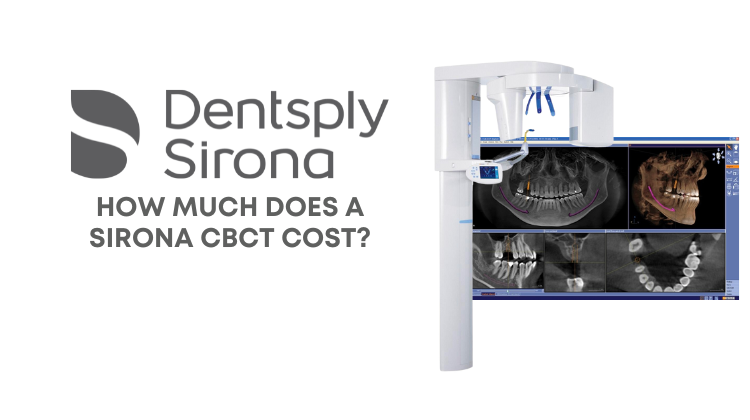What Is a CBCT Used for . . . Besides Implants?
%20-%202023-08-29T150454.801.png)
As you've undoubtedly heard, dental CBCT cone beam and 3D imaging are quickly becoming the new standard of care for dentists and dental specialists.
Dental cone beam imaging gives you the unprecedented ability to evaluate a patient’s dental anatomy in three dimensions. This, then, provides better visualization of anatomical structures for superior treatment planning as compared to traditional 2D radiographs.
Today, many doctors would say CBCT is their most valuable diagnostic tool in their practice. With such a strong promise of ROI and expanded diagnostic capabilities, it’s not surprising that thousands of doctors across the US are making the investment in in-house CBCT systems.
While implant planning is commonly associated with CBCT, your ability to take 3D scans in-house could potentially have an even greater impact on your practice - and help you achieve ROI even faster.
A reasonable jump, based on your doctoral training, would most notably include third molar extractions and endodontics. General practitioners could also consider bringing on full or part-time specialists such as orthodontists, maxillofacial/oral surgeons, sleep/airway specialists, and endodontists to further utilize their in-house CBCT.
Today, we're going to take a deeper dive into the various clinical applications of CBCT that have been successful for dentists and specialists alike.
Endodontic Applications
One of the earliest adoptions of CBCT in dentistry was in the field of endodontics. Traditional two-dimensional radiographs often fall short in revealing the intricate anatomy of root canals. CBCT steps in to provide a three-dimensional view, aiding in identifying complex root canals, diagnosing root fractures, and assessing conditions like apical periodontitis. With the help of CBCT, endodontists can plan more precise and effective treatments.
Orthodontic Assessment
Orthodontics has benefitted tremendously from the advent of CBCT technology. With its help, dental professionals can obtain a comprehensive understanding of the skeletal and dental structures, which is crucial for planning orthodontic treatments. Whether it's assessing the position of impacted teeth or performing cephalometric analyses, CBCT provides detailed insights that can influence treatment outcomes.
Periodontal Disease
Gone are the days when periodontists had to rely solely on clinical examinations and two-dimensional radiographs to assess the severity of periodontal disease. CBCT offers detailed images of the alveolar bone, allowing clinicians to precisely measure bone levels and defects. This is particularly useful for planning procedures like bone grafts or sinus lifts.
Diagnosing Jaw Tumors and Abnormalities
The role of CBCT in the diagnosis and management of jaw tumors and cysts cannot be understated. These high-definition, three-dimensional images enable clinicians to evaluate the size, extent, and involvement of these pathological conditions, thus assisting in the surgical planning and subsequent treatment.
Temporomandibular Joint (TMJ) Analysis
Temporomandibular disorders (TMD) often require intricate diagnosis, involving the assessment of both soft tissue and bone. CBCT technology offers invaluable data about the anatomy and any existing pathology of the TMJ. This allows for more accurate diagnoses and, therefore, more effective treatment plans for patients suffering from TMD.
Airway Studies
In recent years, the use of CBCT in studying airway morphology has gained attention, particularly in relation to obstructive sleep apnea. A CBCT scan can reveal constriction or obstruction in the airway, aiding in the diagnosis and potentially offering therapeutic directions.
Pre-prosthetic Planning
Creating well-fitting crowns, bridges, and dentures requires a detailed understanding of a patient's oral structure. CBCT scans can provide this in a format that is easy for dental technicians and prosthodontists to interpret, thereby ensuring better patient outcomes.
Questions? Reach Out!
Trust us, we know, making the decision to invest in an in-house CBCT takes considerable planning and resources. Upgrading from 2D to 3D imaging has great potential to benefit your patients, staff, and practice as a whole. Following the tips from this article can help you reach that coveted value quicker than you may expect!
Hey, are you still waiting to pull the trigger on an imaging upgrade?
Reach out to the leaders in certified pre-owned dental imaging equipment. For over 10 years, we’ve helped our customers save up to 50% off new list prices. And, because we have deep expertise in dental imaging systems and a wide inventory to choose from, we can help match you with the model and features that will drive the best value from your investment.
Plus, any CBCT you buy from us comes with our comprehensive warranty and five-star customer service. And, if you’re making the upgrade to CBCT, we can speak to you about trading in your current 2D X-ray equipment towards your purchase.
Give us a call today at (888) 246-5611 to speak to your dedicated Sales Representative and start putting together your CBCT purchase plan.


%20(91).png)
